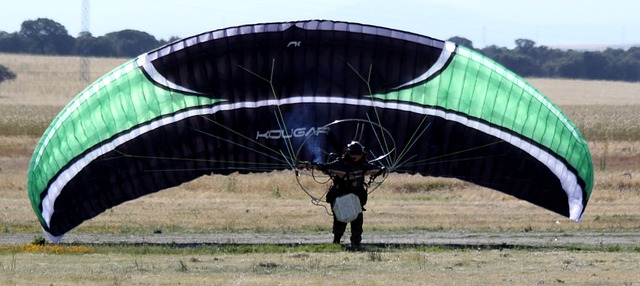Paramotoring is a thrilling and popular adventure sport that involves flying a motorized paraglider. It offers a unique way to experience the world from above and is becoming increasingly popular among adventure enthusiasts. However, one of the essential things to consider when selecting a paramotor is its weight.
The weight of a paramotor can vary depending on its size and design, but the average weight range of a paramotor is between 50 pounds (22.6 kg) to 90 pounds (40.8 kg). Specific models can vary in weight depending on their components, with lightweight paramotors weighing as little as 40 pounds (18 kg) and heavy-duty paramotors weighing more than 100 pounds (45 kg).
When selecting a paramotor, it’s important to consider not only the weight but also other factors like power, maneuverability, and durability, and to understand the pros and cons of different weight ranges. Ultimately, the best choice for you will depend on your individual needs and preferences.
In this article, I’ll explore how much a paramotor weighs, what factors affect its weight, and how to reduce weight if desired. Whether you’re a seasoned paramotor pilot or a beginner looking to get started, this article will provide valuable insights into this crucial aspect of paramotoring. So let’s dive in!
Factors Affecting Paramotor Weight
The weight of a paramotor is determined by various factors, including:
- Motor Size: The size and power of the motor have a direct impact on the weight of a paramotor. Generally, a larger motor will be heavier than a smaller one, which means that more powerful paramotors tend to be heavier.
- Frame Material: The material used for the frame of the paramotor can also affect its weight. Some materials like carbon fiber or titanium are lighter but can be more expensive, while aluminum is a popular and cost-effective option that is still relatively lightweight.
- Propeller: The size and design of the propeller can impact the weight of the paramotor. A larger, more powerful propeller will be heavier than a smaller one.
- Fuel Tank Capacity: The fuel tank’s size and capacity also affect the paramotor’s weight. A larger fuel tank means that the paramotor can fly for a more extended period, but it also adds to the overall weight of the machine.
- Harness: The harness is an essential part of the paramotor, and its design can impact the weight. A more complex and comfortable harness will generally be heavier than a simple one.
- Other Components: Other components like the battery, throttle, and safety equipment can also add to the paramotor’s overall weight.
Understanding these factors can help you make an informed decision when selecting a paramotor that meets your needs while balancing weight and performance. In the next section, we’ll explore the average weight range of paramotors.
Average Weight of a Paramotor
The weight of a paramotor can vary depending on the size and design of its components. On average, a paramotor can weigh anywhere from 50 pounds (22.6 kg) to 90 pounds (40.8 kg). This weight includes the motor, frame, propeller, harness, fuel tank, and safety equipment.
However, it’s important to note that some paramotors can weigh less or more than this average range depending on their specific design and components. For instance, lightweight paramotors that are designed for competition or adventure flying can weigh as little as 40 pounds (18 kg) or less. On the other hand, heavy-duty paramotors with larger motors and more robust frames can weigh more than 100 pounds (45 kg).
The weight of a paramotor can have a significant impact on its performance, maneuverability, and portability. Lighter paramotors tend to be more agile and have better fuel efficiency, but they may not be as durable or have as much power. Heavier paramotors, on the other hand, can be more stable in windy conditions and have more power, but they may be more challenging to transport and require more fuel.
When choosing a paramotor, it’s important to consider your individual needs and preferences, as well as the specific conditions you’ll be flying in.
Paramotor average weight range based on industry standards and popular models
Based on industry standards and popular models, the average weight range of a paramotor is between 50 pounds (22.6 kg) to 90 pounds (40.8 kg). Here are the average weights of some popular paramotors:
- Parajet Zenith: The Parajet Zenith is a popular lightweight paramotor, weighing approximately 46 pounds (21 kg).
- Air Conception Nitro 200: The Air Conception Nitro 200 is another popular paramotor that weighs around 55 pounds (25 kg).
- Flat Top Ninja: The Flat Top Ninja is a well-known paramotor that weighs around 75 pounds (34 kg).
- Fresh Breeze Simonini: The Fresh Breeze Simonini is a heavy-duty paramotor that weighs around 90 pounds (40.8 kg).
It’s important to note that these are just average weights, and specific models can vary in weight depending on their specific components and design. When selecting a paramotor, it’s essential to consider not only the weight but also other factors like power, durability, and portability.
The pros and cons of different weight ranges for paramotors
There are pros and cons to different weight ranges for paramotors, and the best choice for you will depend on your individual needs and preferences. Here are some of the key advantages and disadvantages of different weight ranges:
Lightweight Paramotors Pros:
- Easy to transport and maneuver
- Better fuel efficiency
- Can be more agile and responsive
Cons:
- May not be as durable
- May not have as much power
- Can be more affected by wind and turbulence
Midweight Paramotors Pros:
- Balance of portability and power
- Can be more stable in wind and turbulence
- May have better durability
Cons:
- Can be more challenging to transport
- May not be as agile and responsive as lightweight paramotors
- Can have lower fuel efficiency than lightweight models
Heavy-Duty Paramotors Pros:
- More powerful
- More stable in wind and turbulence
- Can have better durability
Cons:
- More challenging to transport and maneuver
- Lower fuel efficiency
- Can be more expensive
It’s essential to consider these pros and cons when selecting a paramotor. For example, if you plan to travel frequently with your paramotor and need to transport it easily, a lightweight model may be the best option. On the other hand, if you plan to fly in windy conditions or need more power, a heavy-duty paramotor may be a better choice.
Ultimately, the weight of the paramotor is just one factor to consider when selecting a model. Other factors like power, maneuverability, and durability are also important to consider.
Common misconceptions about the weight of paramotors
There are some common misconceptions about the weight of paramotors that are worth addressing. Here are a few:
- “Lighter is always better”: While lighter paramotors can be more agile and have better fuel efficiency, they may not be the best choice for everyone. Heavier paramotors can be more stable in windy conditions and have more power, which can be important for certain types of flying.
- “The lightest paramotors are always the most expensive”: While some lightweight paramotors can be expensive, there are also affordable lightweight models available on the market. The cost of a paramotor depends on many factors, including the components used, the brand, and the level of technology and features.
- “A heavy-duty paramotor is always more durable”: While heavy-duty paramotors can be more durable than lightweight models, durability depends on many factors besides weight. The quality of the components used, the manufacturing process, and how well the paramotor is maintained can all impact its durability.
- “A heavier paramotor is always harder to transport”: While heavier paramotors can be more challenging to transport than lightweight models, there are ways to make transportation easier. For example, some manufacturers offer transport bags or cases that make it easier to transport the paramotor.
Understanding these misconceptions can help you make informed decisions when selecting a paramotor that meets your needs. It’s essential to consider not only the weight of the paramotor but also other factors like power, maneuverability, and durability.
Lightest and Heaviest Paramotors
The weight of a paramotor can vary widely depending on the specific model and its components. Here are some examples of the lightest and heaviest paramotors currently available on the market:
Lightest Paramotors:
- Nirvana Instinct: The Nirvana Instinct is one of the lightest paramotors available, weighing in at just 40 pounds (18 kg). It is designed for competition and adventure flying, and its lightweight design makes it highly maneuverable.
- Scout Carbon Fiber: The Scout Carbon Fiber is another lightweight paramotor, weighing around 46 pounds (21 kg). It features a carbon fiber frame and a powerful motor, making it an excellent choice for advanced pilots.
Heaviest Paramotors:
- Fresh Breeze Monster: The Fresh Breeze Monster is one of the heaviest paramotors on the market, weighing around 130 pounds (59 kg). It features a robust frame and a powerful motor, making it suitable for heavy-duty use and tandem flying.
- HE Paramotors Thor 250: The HE Paramotors Thor 250 is another heavy-duty paramotor, weighing around 115 pounds (52 kg). It is designed for tandem flights and features a large fuel tank and a powerful motor.
It’s important to note that the weight of a paramotor is just one factor to consider when selecting a model. Other factors like power, maneuverability, and durability are also important to consider. In general, lightweight paramotors are more agile and fuel-efficient, while heavy-duty paramotors are more powerful and stable in windy conditions. Ultimately, the best choice for you will depend on your individual needs and preferences.
Tips for Reducing Paramotor Weight
Reducing the weight of a paramotor can offer several benefits, such as improved fuel efficiency and increased maneuverability. Here are some tips for reducing the weight of a paramotor:
- Use lightweight materials: When selecting a paramotor, look for models that use lightweight materials like carbon fiber or titanium for the frame and other components. These materials are strong and durable but weigh less than traditional materials like aluminum.
- Opt for a smaller fuel tank: While a larger fuel tank may offer longer flight times, it also adds weight to the paramotor. Consider opting for a smaller fuel tank if you don’t plan on flying for extended periods.
- Choose a smaller motor: A smaller motor will be lighter than a larger one, which can help reduce the overall weight of the paramotor. However, it’s important to ensure that the motor is powerful enough to generate the thrust needed to lift the paramotor.
- Use a lightweight harness: The harness is an essential component of the paramotor, but some models can be heavy. Look for harnesses that use lightweight materials like Kevlar or Dyneema to reduce weight.
- Use a lightweight wing: The wing is another critical component of the paramotor, and selecting a lightweight model can help reduce the overall weight. However, it’s important to ensure that the wing is still suitable for your flying style and experience level.
- Minimize additional equipment: Avoid adding unnecessary equipment to the paramotor, as each additional item will add weight. Consider only bringing essential safety equipment, like a reserve parachute and helmet.
It’s important to note that reducing the weight of a paramotor shouldn’t come at the expense of safety or performance. Always consult with a professional before making any modifications to your paramotor, and ensure that any changes made meet safety standards and don’t compromise the machine’s performance.
Conclusion
The weight of a paramotor is an essential factor to consider when selecting a model that meets your needs. The average weight range of a paramotor is between 50 pounds to 90 pounds, but how much does a paramotor weigh will always depend on the specific model, design, and components.
There are pros and cons to different weight ranges, and the best choice for you will depend on your individual needs and preferences. Lightweight paramotors are more agile and fuel-efficient, while heavy-duty paramotors are more powerful and stable in windy conditions.
Reducing the weight of a paramotor can offer benefits like improved fuel efficiency and increased maneuverability. However, it’s important to ensure that any changes made meet safety standards and don’t compromise the machine’s performance.
Overall, understanding the factors that affect paramotor weight and the different models available can help you make an informed decision when selecting a paramotor that meets your needs and preferences. So whether you’re a seasoned pilot or a beginner looking to get started, take the time to research and consider all the factors before making a purchase.
This is another great article you should read: Can Anyone Fly A Paramotor?








